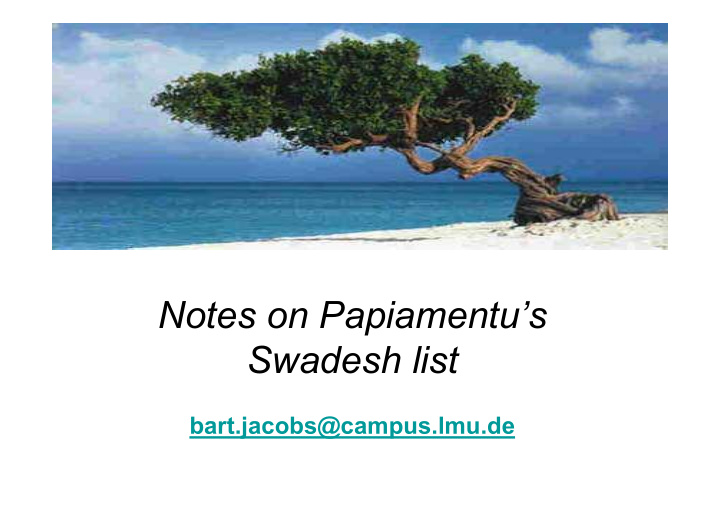



Notes on Papiamentu’s Swadesh list bart.jacobs@campus.lmu.de
Mixed Spanish/Portuguese vocabulary PA blanku ‘white’ < Sp. blanco PA pretu ‘black’ < Port. preto - Bon nochi -Ki tin, swa? -Mi ta bai bon, danki. -Kon ta bo nomber? -Mi yama Wan.
UG ABC GG A N G
• “Relexification from an African Portuguese Creole does not strike me as particularly likely” (Parkvall 2000) • Papiamentu “is not clearly related to any West African creole” (Lipski 2005) • “Scholars are still evenly divided as to the Spanish vs. Portuguese origins of Papiamentu” (Lipski 2005) • “Algunos estudiosos ponen en tela de juicio su origen hispánico y defienden su filiación portuguesa, pero en la actualidad esta posición ha perdido mucho terreno” (Munteanu 2008).
UG ABC GG A N G
Concensus on origins of slaves • “For most of the 17th and early 18th centuries, Lower Guinea (...) was the major supplier of slaves to Curaçao [and] there was also a sizeable Bantu contingent, with the number of Senegambians being virtually negligible” (Parkvall 2000). • “Es sind vor allem Bantudialekte aus der Region Kongo/Angola und Kwadialekte aus der Region, die sich von Ghana bis Nigeria erstreckt, die als afrikanische Basissprachen des Papiamentu in Frage kommen.” (Maurer 1991) • “The Senegambia region held little significance for the Dutch slave trade” (Postma 1990)
Lacuna in the data • “Unfortunately, there are no data for pre- 1674 arrivals.” (Parkvall 2000). • De Moraes (1993-1998) • “1667 - 1675, the peak period of importation 24,000 African enslaved people were shipped to Curaçao” (Allen 2007).
1621 1634 1640 1648 UG ABC GG 1672-1678 A N G
Distinction content words <> function words Muysken&Smith (1990): “Function words (…) are normally less susceptible to replacement (...) than content words, as is demonstrated in the study of Indo- European languages” Cardoso (2004): In a case of relexification “one would expect a much slower replacement (…) among function words”
Prepositions PA di, ku, na, pa, riba, te PA banda di , for di , UGC di, ku, na, pa, riba, te UGC banda di , fora di
Structural correspondence in all functional categories • Pronouns • Prepositions • Conjunctions - Question Words • Morphology • Modal verbs • TMA markers • Reflexivity, reciprocity • Old (15th-16th century) Portuguese • Early (pre-20th century) Papiamentu
Notes on the Swadesh list
Pronouns PA UGC (a)mi (a)mi (a)bo (a)bo e(l) el (a)nos (a)nos (a)boso (a)bos (a)nan (a)elis
• “The use of 3pl for nominal plural marking might potentially be a case of late substrate influence. Its absence in many of the world’s languages proves it to be a feature that human language, regardless of whether it has gone through pidginization or not, can manage without. Indeed, overt plural marking has been shown to be a late development in the Indian Ocean FCs (…) and it was moderately grammaticalised in Negerhollands DC, which could be taken to suggest a relatively late development”.
Question words PA UGC ken ken `who` unda unde `where` ki ki `what` ki tempu ki tempu `when` ki dia ki dia ki ora ki ora
Functional verbs PA bin UGC bin ‘to come’ PA ker UGC kere ‘to want’ PA por UGC podi ‘to can, be able’ PA bai UGC bai ‘to go’ PA tin, tene UGC ten, tene ‘to have’ PA meste, mesté UGC meste, mestedu ‘to need, be needed’ PA bira UGC bira ‘to become’ PA la(r)ga UGC larga ‘to let’
Masha danki……!! Tin preguntanan?
Recommend
More recommend